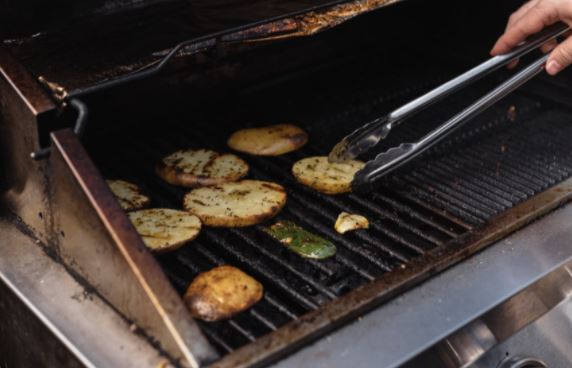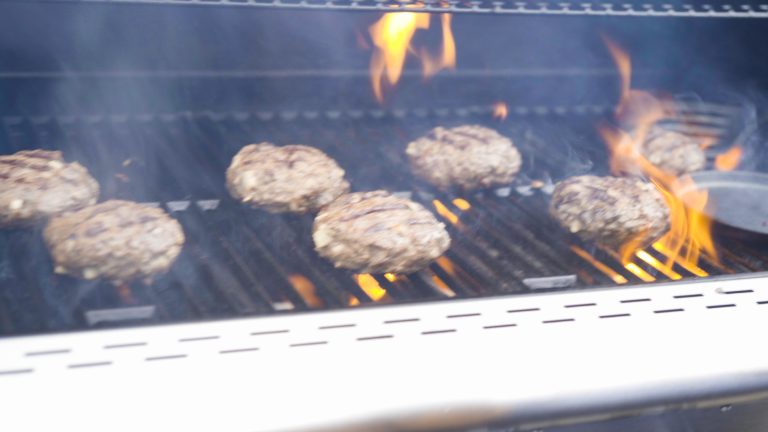How to Clean a Gas Grill
Cleaning a Gas Grill Deeply and Thoroughly
Cleaning a natural gas or propane grill is fairly straightforward. How it differs from cleaning a charcoal grill is that you have to disconnect the gas supply source when cleaning the parts for safety.
For deep cleaning your gas grill, you will need:
• Floor or ground covering such as a tarp
• Microfiber cleaning cloths or rags
• Grill brush
• Paper clips
• Dishwashing liquid and warm or hot soapy water
• Scraper or spatula
• Stainless steel cleaner (only for stainless steel grills) or a grill cleaner designed specifically for stainless steel grills
• Dustpan
• ShopVac
1
To clean a gas grill, start by lighting the grill and allowing it to reach its maximum temperature before turning off the heat. Allow at least 30 minutes for the intense heat to singe any food or fat that has become attached to the pan. After that, soak the wire brush in a bucket of warm, soapy water for a few minutes to remove all of the carbon from the grates. Allow the grill to cool completely before using it.
2
Turn the natural gas off at the main valve, disconnect the propane tank. While this may seem like a simple step, it is sometimes overlooked despite the fact that it is quite crucial.
So, before you do anything, locate the source of the gas, whether it’s the gas supply valve on a propane tank or the connection point for natural gas-fueled barbecues, and turn it off before proceeding. Check your gas line again before proceeding.
3
Protect Your Working Environment
Making sure that the location in which you intend to clean your grill, or just place removed grill components, is well protected is the next step. This applies to the ground as well as the ceiling.
It is important to note that different chemicals react differently with different surfaces. The last thing you want to do is spend hours cleaning your grill only to discover that you have damaged your beloved garden table or soiled your decking area with grease from the grates.
Newspapers or tarps will suffice in this situation (tarps are preferred) because they are not easily penetrated by cleaning chemicals.
Another thing to remember is to make certain that any youngsters or pets are kept out of the area while cleaning.
4
Disassemble your grill and clean out any large lumps, flakes, and dirt that may have accumulated.
Remove the majority of the dirt and debris from your grill components with a scraper, a dustpan, and a brush before allowing any water to come into contact with them.
During the grilling process, grease and carbon accumulate on the interior of the lid, the sides of the grill, and the base of the grill.
Remove any grates, any Flavorizer bars, burner assemblies, drip trays, and anything else that can be removed, and set them away for cleaning as quickly as possible.
Then, using a scraper, work your way around the interior of the lid and the sides of the grill, scraping away at the bottom of the grill to remove as much dirt and buildup as you can while the grill is still dry.
The dry bulk can be removed now, before the items are soaked in hot soapy water, and this will limit the amount of greasy water that leaks out into the surrounding floor.
Cleaning the Grill Interior
1
Remove all of the grates and flavorizer bars from the grill and completely soak them in a tub of warm, soapy water once it has cooled down. Allow for at least 30 minutes of soaking time. You should also remove any other parts of the grill that you can readily remove, such as the burner-control knob or warming rack, and any grease pans. On most gas grills, you can also remove the burner tubes; look for a single screw or cotter pin on one end of each tube to make this happen. The grill will be much easier to clean when it has been stripped down in this manner.
2
Clean the inside of the lid and the sides with a soft cloth.
Using a scourer and warm soapy water, gently scrub the interior lid and sides of the container.
You must start with the lid and work your way down the sides, with the bottom of the grill being the last part to clean later, or you may end up having to clean the entire grill twice.
3
Grate Cleaning
Even after only one or two uses, grill grates will begin to acquire food residue and become discolored. When the season is through, the grit can be thick on the grates! As a result, they do require a thorough cleaning every now and then.
Instead, use a bristle-free grill brush and warm soapy water to scrub both sides until they are clear of filth and shining.
Run the brush along the length of the grills rather than across them, as this will allow you to clean them more quickly while also preventing spatter from getting all over your clothes and other surfaces.
4
Flavorizer bar cleaning
On the majority of grills, there is some form of cover over the gas burners, which is commonly known as a flavorizer Bar or heat diffuser.
Flavorizer Bars are now more often used because they distribute heat more evenly and direct drippings away from the burner tubes. As a result, it’s critical to keep them clean, not only to ensure more equal cooking, but also to minimize flare-ups and prevent the burners from clogging.
Simply make that these guys are removed from the grill and then scrub both sides with a scourer and warm soapy water. They take a lot of abuse from drippings, so they will take some effort.
5
Now that the grill grates and flavorizer bars have been taken off, you can see the inside of the firebox, which is ready to be cleaned. To begin, place an empty bucket behind the firebox, right below the grease tray entrance, to collect the soapy water and debris that has been flushed out of the chimney. Scrape the inside of the firebox with a plastic putty knife to remove any caked-on crud that has formed.
After that, gather any loose debris that has remained with a wet/dry vacuum. In light of the fact that shop vacs are mostly used in the workshop, you shouldn’t feel awful about using one to remove the crud that has accumulated in your grill. Once the firebox has been thoroughly cleaned, it should be rinsed with a garden hose.
6
Clean the Burner Tubes
As previously stated, the Flavorizer Bars or metal plates should have provided ample protection; therefore, a gentle wipe down with a sponge and warm soapy water should be sufficient.
Make a visual inspection of your burners for signs of corrosion or anything that might be obstructing the row of flame-emitting holes. If your grill is left unattended for an extended period of time, the burner tubes become an enticing breeding ground for spiders. Apply pressure to the row of holes with a wire brush, moving it back and forth.
During the process of wiping them off, make sure that none of the holes are clogged, as this can interfere with the passage of gas, resulting in uneven heating and inconsistent results from your grill.
As a result, if you see any clogged holes, carefully remove the debris with a paper clip that has been opened to clean any blocked holes.
7
Clean the drip pan.
The majority of grills are equipped with a grease management system, which results in a removable grease tray at the bottom of the grill.
Using a metal scraper, scrape away any excess grease from the surface of the pan into a wastebasket.
Once the majority of the debris has been removed, give it a thorough scrub down with a scourer and warm soapy water.
By this point, the water will most likely be nasty and full of oil, so replace it with new, clean water and a small amount of liquid dish soap to clean it up.
8
Scrub the Bottom of the Grill
Assuming that all replaceable elements have been removed and thoroughly cleaned, reaching the bottom of the grill should be easy.
Remove any big amounts of grease and buildup from the bottom of the grill with a scraper before scouring it out with a scourer and warm soapy water to finish cleaning it.
9
Reassemble your grill.
Once everything has been completed, reconnect the propane tank or gas source, close the hood, and light the grill. Allow it to heat for at least 15 minutes before turning it off. In addition to helping to burn off any cleaning residue and season the cast-iron grates, this initial firing will serve as proof that you have rebuilt everything correctly.
Once you’ve finished, switch off the burners.
Before you begin cleaning the outside, as you did previously, you should double-check that the gas has been turned off.
Simply wash and rinse with soapy water to remove the stains.
It’s a good idea to start over with fresh, warm soapy water after you’ve finished cleaning. In any other case, you’ll end up with grease stains all over the outside of your grill, which is never a pleasant sight.
Using a sponge, carefully scrub the exterior of the vehicle all over, paying special attention to the grooves and knobs where filth tends to accumulate.
A scourer should not be used since it will scratch the paintwork or surface.
Your outdoor entertaining experience will be improved if your grill is clean. It will help your outdoor kitchen and countertops look better, too, as it impresses your guests with the quality of your food and presentation.






